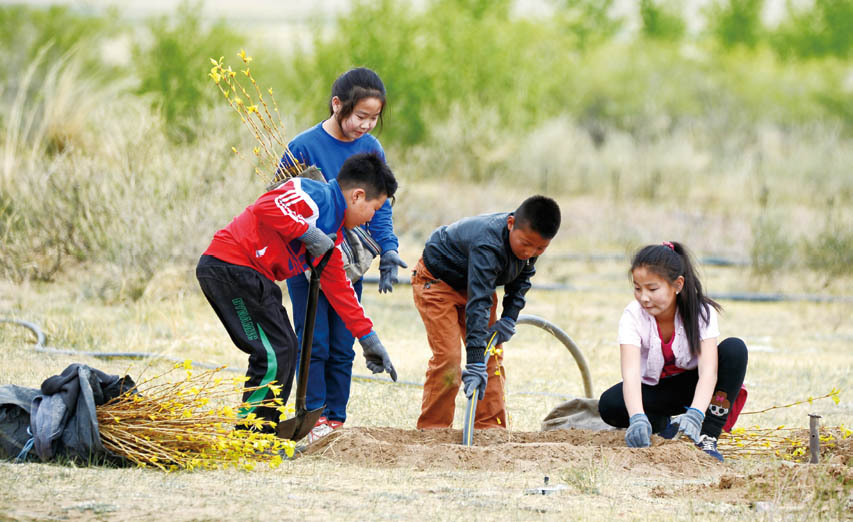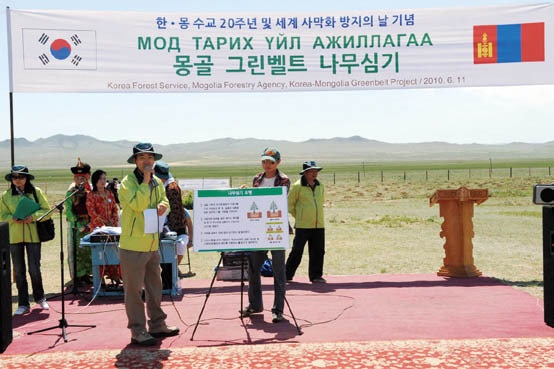Korea plants green dreams in Mongolia
Korea-Mongolia Greenbelt Plantation Project turns 3,000 hectares of desert into forest
By Kim Da-solPublished : Oct. 28, 2021 - 16:08
Arid, rocky desert stretching out across the horizon with no end in sight, with heavy sandstorms carving out dry steppe land from time to time.
This may be what you would normally imagine when you think of Mongolia, home to Asia’s largest and coldest desert -- Gobi Desert.
In a country where forests only cover less than 10 percent of the total land, afforestation is innately difficult -- it has a very short growing season that is restricted by cold temperatures and low precipitation.
This may be what you would normally imagine when you think of Mongolia, home to Asia’s largest and coldest desert -- Gobi Desert.
In a country where forests only cover less than 10 percent of the total land, afforestation is innately difficult -- it has a very short growing season that is restricted by cold temperatures and low precipitation.

By 2005, 78 percent of land in Mongolia had undergone desertification. To tackle the issue, the Mongolian government devised a plan to form a greenbelt over 202,000 hectares of land to not only combat drought but climate change, natural disasters and environmental pollution.
After spending a decade planting trees in Mongolian cities including Lun, Dalanzadgad and Bayanzag, some 3,000 hectares of deserted land have turned into unpolluted, lush woodland.
And South Korea’s Korea Forest Service has been behind Mongolia’s forestation efforts since 2007.
Besides planting trees, the KFS has also set up plant nurseries in Lun, Dalanzadgad and Bayanzag over a combined 45 hectares of land to offer afforestation technology training sessions for some 8,000 Mongolian officials and residents.
After spending a decade planting trees in Mongolian cities including Lun, Dalanzadgad and Bayanzag, some 3,000 hectares of deserted land have turned into unpolluted, lush woodland.
And South Korea’s Korea Forest Service has been behind Mongolia’s forestation efforts since 2007.
Besides planting trees, the KFS has also set up plant nurseries in Lun, Dalanzadgad and Bayanzag over a combined 45 hectares of land to offer afforestation technology training sessions for some 8,000 Mongolian officials and residents.

In 2017, the two countries kicked off a bilateral reforestation project to plant some 40 hectares of urban forest in the capital, Ulaanbaatar.
The urban forest, filled with some 30,000 trees, includes a playground, sport facilities, a natural arboretum, a fountain and a visitor information center. The forest opened its doors to the public last month.
South Korea’s effort to support Mongolia’s program to reforest desert areas are continuing.
Last month, KFS Minister Choi Byeong-am visited Mongolia’s Ministry of Environment and Tourism to sign a deal, the two countries’ third project to fight Mongolia’s deforestation.
Some $8 million will be injected to reforest Mongolia’s northern areas which have been damaged by wildfires. It will be also used to train local workforce and research on agroforestry from 2022 to 2026.
South Korea’s efforts fall in line with the Mongolian government’s Green Belt National Program of Mongolia, which intends to reforest areas in the Gobi Desert and the country’s steppe regions by 2035.
“The agreement between the two countries reflect not only the current global trends to address environmental issues like climate change but also recognizes the significance of achieving land degradation neutrality which was adopted as a sustainable development goal target at the UN Assembly in 2015,” said the KFS.
The urban forest, filled with some 30,000 trees, includes a playground, sport facilities, a natural arboretum, a fountain and a visitor information center. The forest opened its doors to the public last month.
South Korea’s effort to support Mongolia’s program to reforest desert areas are continuing.
Last month, KFS Minister Choi Byeong-am visited Mongolia’s Ministry of Environment and Tourism to sign a deal, the two countries’ third project to fight Mongolia’s deforestation.
Some $8 million will be injected to reforest Mongolia’s northern areas which have been damaged by wildfires. It will be also used to train local workforce and research on agroforestry from 2022 to 2026.
South Korea’s efforts fall in line with the Mongolian government’s Green Belt National Program of Mongolia, which intends to reforest areas in the Gobi Desert and the country’s steppe regions by 2035.
“The agreement between the two countries reflect not only the current global trends to address environmental issues like climate change but also recognizes the significance of achieving land degradation neutrality which was adopted as a sustainable development goal target at the UN Assembly in 2015,” said the KFS.

On Sept. 22, Mongolian President Ukhnaagiin Khurelsukh said at the latest United Nations General Assembly in New York that the country is determined to “fight against climate change with achievements of the modern science and technology as well as best practices and the traditional experiences.”
He said the country has launched a campaign to plant billions of trees by 2030, inspired by lessons from the traditional Mongolian “nomadic civilization” to respect and treat nature deferentially.
Earlier this month, Khurelsukh also ordered to establish the Forestry Administration and inject at least 1 percent of the country’s GDP for funds to tackle climate change and desertification.
By Kim Da-sol and Lee Kwon-hyung
(ddd@heraldcorp.com)
(kwonhl@heraldcorp.com)
He said the country has launched a campaign to plant billions of trees by 2030, inspired by lessons from the traditional Mongolian “nomadic civilization” to respect and treat nature deferentially.
Earlier this month, Khurelsukh also ordered to establish the Forestry Administration and inject at least 1 percent of the country’s GDP for funds to tackle climate change and desertification.
By Kim Da-sol and Lee Kwon-hyung
(ddd@heraldcorp.com)
(kwonhl@heraldcorp.com)


















![[KH Explains] Hyundai's full hybrid edge to pay off amid slow transition to pure EVs](http://res.heraldm.com/phpwas/restmb_idxmake.php?idx=652&simg=/content/image/2024/04/18/20240418050645_0.jpg&u=20240418181020)

![[Today’s K-pop] Zico drops snippet of collaboration with Jennie](http://res.heraldm.com/phpwas/restmb_idxmake.php?idx=642&simg=/content/image/2024/04/18/20240418050702_0.jpg&u=)